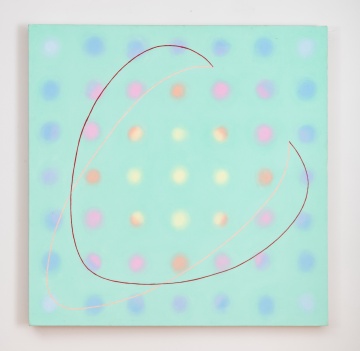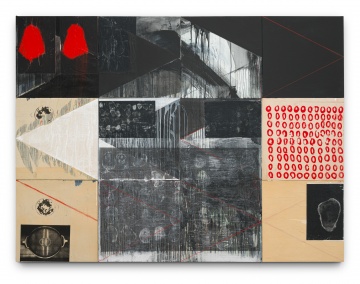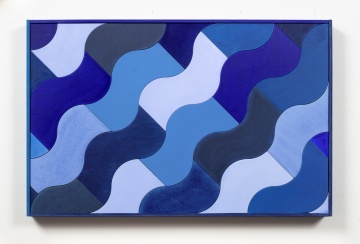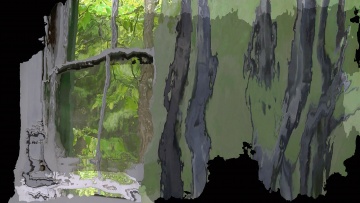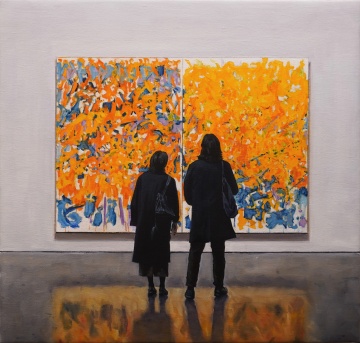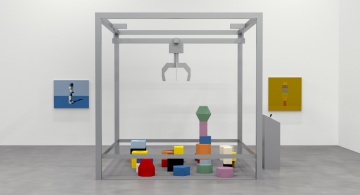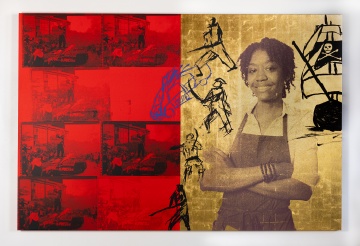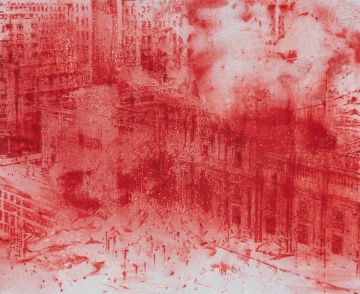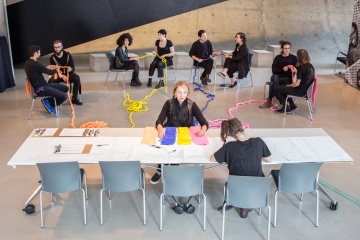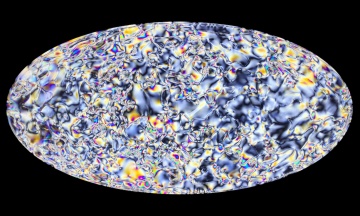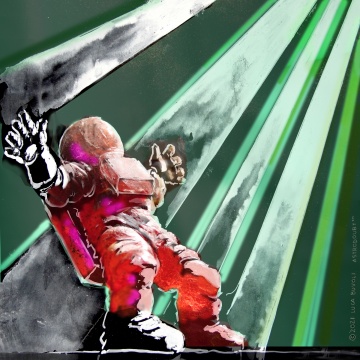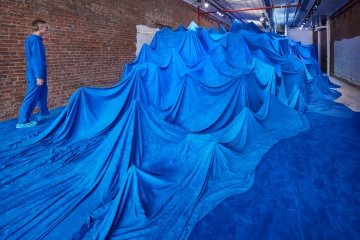Cristin Tierney Gallery
219 Bowery, 2nd Floor
New York, NY 10002
212 594 0550
New York, NY 10002
212 594 0550
Founded in 2010, Cristin Tierney Gallery is a contemporary art gallery located on The Bowery with a deep commitment to the presentation, development and support of a roster of both established and emerging artists. Its program emphasizes artists engaged with critical theory and art history, with an emphasis on conceptual, video, and performance art. Education and audience engagement is central to our mission.
Artists Represented:
Melanie Baker
Melanie Baker
Janet Biggs
Claudia Bitrán
François Bucher
Victor Burgin
peter campus
Joe Fig
Julian V.L. Gaines
MK Guth
Malia Jensen
Alois Kronschlaeger
Shaun Leonardo
Joan Linder
Jennifer Marman and Daniel Borins
T. Kelly Mason
Maureen O'Leary
Dread Scott
Mark Sengbusch
Jorge Tacla
Francisco Ugarte
John Wood and Paul Harrison
Tim Youd
Works Available By:
Melanie Baker
Melanie Baker
Janet Biggs
Claudia Bitrán
François Bucher
Victor Burgin
peter campus
Joe Fig
Julian V.L. Gaines
MK Guth
Malia Jensen
Alois Kronschlaeger
Shaun Leonardo
Joan Linder
Jennifer Marman and Daniel Borins
T. Kelly Mason
Maureen O'Leary
Dread Scott
Mark Sengbusch
Jorge Tacla
Francisco Ugarte
John Wood and Paul Harrison
Tim Youd


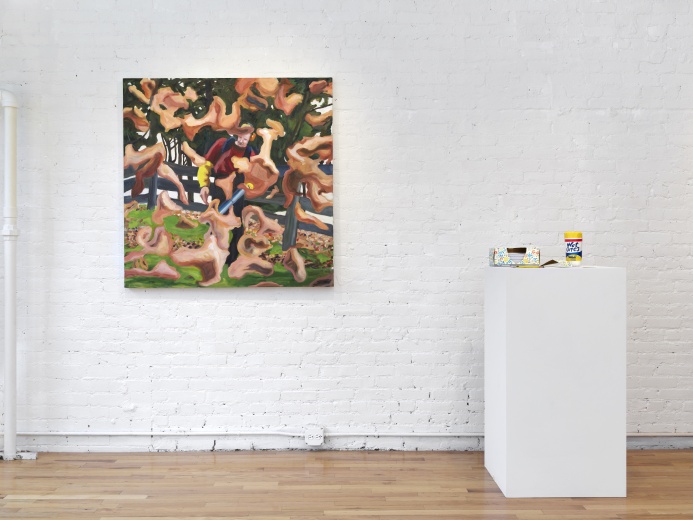
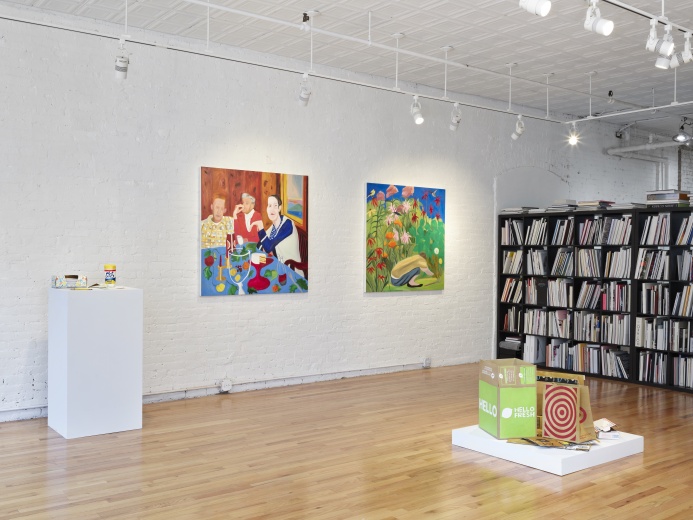

Installation view of Joan Linder and Maureen O'Leary: Slightly Surreal Suburbia. Photograph by Elisabeth Bernstein.
Installation view of Joan Linder and Maureen O'Leary: Slightly Surreal Suburbia. Photograph by Elisabeth Bernstein.
Installation view of Joan Linder and Maureen O'Leary: Slightly Surreal Suburbia. Photograph by Elisabeth Bernstein.
Installation view of Joan Linder and Maureen O'Leary: Slightly Surreal Suburbia. Photograph by Elisabeth Bernstein.
Installation view of Joan Linder and Maureen O'Leary: Slightly Surreal Suburbia. Photograph by Elisabeth Bernstein.
Diane Burko
Bearing Witness
January 31, 2025 - March 8, 2025
Cristin Tierney Gallery is pleased to present Bearing Witness, a solo exhibition of new and recent mixed-media paintings by Diane Burko. The exhibition opens Friday, January 31st with a reception from 6:00 to 8:00 pm, and will be on view through March 8, 2025. This marks Burko's first solo exhibition in New York in over forty years and her debut solo show at the gallery. The artist will be present at the opening reception.
Driven by endless curiosity and an unwavering commitment to environmental preservation, Burko has spent five decades "bearing witness" to the realities of climate change. Her work offers a visual record of these investigations, drawing on visits to extreme environments worldwide-from the Arctic to the Amazon, coral reefs to deserts. The paintings in Bearing Witness reflect this journey, channeling her observations into emotionally charged works that seek to inspire global solidarity in defense of our shared ecosystem.
Through her art, Burko combines aesthetic experience with scientific and personal narratives. She augments her practice with public engagement, weaving facts and stories into the viewing experience to deepen its impact. By imbuing her work with a sense of authenticity and purpose, she aspires to spark civic awareness and action.
Burko's World Glacier and World Reef series are central to the exhibition, with their focus on the escalating effects of climate change. In her studio, the artist painted works from both series on opposite walls, allowing her to draw connections between them. The Reef series captures the devastation wrought by warming seawater and coral bleaching. In contrast, paintings from the Glacier series, such as Glacier Map 1 (2019), depict the alarming retreat of ice as seas encroach on glaciers. Layers of blue and black acrylic and crackle paint evoke melting ice and rising waters, while faint, map-like lines allude to the scientific data underpinning her work. Burko employs techniques like pouring, sanding, and air-compressing paint to create textured surfaces that echo the fragility of the natural world.
"I struggle to use the language of paint to develop new vocabulary-to create visual poetry that draws you in, compels you to look closely, and then reveals some ugly truths," Burko explains. These "ugly truths" emerge in Bearing Witness through works that fuse collaged elements with expressive abstraction. By juxtaposing beauty with adversity, Burko makes the pressing threat of climate change feel both urgent and personal.
At its core, Burko's practice is about paying homage to a changing Earth while sounding a call to action. Yet her art transcends this mission; it moves beyond reason, propelled by a sensibility that transforms scientific data and environmental loss into an expressive, emotional experience.
Diane Burko's (b. 1945, New York, NY) work in painting, photography, and time-based media considers the marks that human conversations make on the landscape. A Professor Emerita of the Community College of Philadelphia with additional teaching experience at Princeton University, Burko has received multiple grants from the NEA, the Pennsylvania Arts Council, the Leeway Foundation, and the Independence Foundation. She has received a Lifetime Achievement Award from the Women's Caucus for Art.
After focusing for several decades on monumental geological formations and waterways through landscape painting, Burko has shifted in the past 20 years to analyze the impact of industrial and colonial activity on those same landscapes. The artist's practice seeks to visually emulsify interconnected subjects-extraction, deforestation, extinction, environmental justice, Indigenous genocide, ecological degradation, and climate collapse-so viewers might feel their connection viscerally through the beauty of her work. While her work deals with impending climate catastrophe, rather than lingering in dystopia, it celebrates the landscape's sublimity by honoring the intricate geological and political webs that shape the identity of a place.
Burko has exhibited extensively nationally and internationally, including shows at London's Royal Academy of Art, Minneapolis Art Institute, National Academy of Sciences, Phillips Collection, RISD Museum, Tang Museum, and Wesleyan University Center for the Arts. She has been awarded residencies in Giverny, Bellagio, the Arctic Circle, and the Amazon Rainforest. In 2021, her solo exhibition Seeing Climate Change at the American University Museum was cited in the New York Times as one of the best shows of 2021. Her work is held in 40 public collections nationwide, including the Art Institute of Chicago, Denver Art Museum, Everson Museum of Art, Hood Museum of Art, Minneapolis Institute of Art, Phillips Collection, and The Philadelphia Museum of Art, among others. Burko's studio is located in Philadelphia, PA.
Founded in 2010, Cristin Tierney Gallery is a contemporary art gallery located on The Bowery with a deep commitment to the presentation, development, and support of a roster of both established and emerging artists. Its program emphasizes artists engaged with critical theory and art history, with an emphasis on conceptual, video, and performance art. Education and audience engagement is central to our mission. Cristin Tierney Gallery is a member of the ADAA (Art Dealers Association of America).
Audra Skuodas
Vibrational Vulnerability
October 25, 2024 - January 17, 2025
Cristin Tierney Gallery is pleased to announce Vibrational Vulnerability, a solo exhibition of rarely seen paintings and drawings from the estate of Audra Skuodas. This is the artist's first solo exhibition with the gallery and the first presentation of her work in New York in over fifteen years. Vibrational Vulnerability opens on Friday, October 25th, with a reception from 6:00 to 8:00 p.m. The exhibition will be on view through December 14th, 2024.
Skuodas epitomizes the "under-recognized artist." Virtually unknown to a larger audience throughout her life, her oeuvre found greater attention only after her death when it was prominently featured in the 2022 Cleveland Triennial: Front. Over the past several years, museums such as the Allen Memorial Art Museum, Oberlin, and the Cleveland Museum of Art have begun acquiring and exhibiting her work. A major museum is planning a retrospective exhibition with a publication.
Despite a lifetime of relative obscurity, Skuodas' work resonates with profound depth and a distinctive voice that challenges conventional boundaries of perception and form. Perpetually experimenting with materials, she explored beads, sequins, and vibrant fabrics, creating rigid and soft sculptures alongside quilts, books, and jewelry. Her paintings and drawings--initially aligned with Surrealism and before transitioning to abstraction starting in the 1980s--are where she gained renown the most.
Vibrational Vulnerability features figurative and abstract paintings, works on paper, and unique stitched drawings from her Womb Wound series. As a soul-searcher who studied science, mysticism, and Eastern religions, Skuodas sought to convey universality in her art. She blended geometric form with emotional intelligence and the feminine. In her later years, Skuodas' thinking was informed by what she called "the law of limits: that invisible phenomenon of tension and attraction which maintains the cosmic order."
Emblematic of Skuodas' quest for knowledge, the paintings in Vibrational Vulnerability combine scientific inquiry with mystical introspection. They beckon the viewer into a contemplative space where alternative narratives and perspectives converge, urging them to reconsider their relationship with the cosmos and our place within it.
Audra Skuodas (1940-2019) was born in Lithuania and lived for six years in a displaced persons camp in Germany before coming to the U.S. in 1949. She became a US citizen in 1961 and earned a B.A. and M.A. at Northern Illinois University. She taught and exhibited her work throughout her career, and was associated with institutions such as the Nova Scotia College of Art and Design, the Cleveland Institute of Art, and Oberlin College. She exhibited in Chicago with Richard Gray, and in New York with Moti Hassan, as well as at regional spaces in the Cleveland area. In 2010, she received the Cleveland Arts Prize Lifetime Achievement Award.
Founded in 2010, Cristin Tierney Gallery is a contemporary art gallery located on The Bowery with a deep commitment to the presentation, development, and support of a roster of both established and emerging artists. Its program emphasizes artists engaged with critical theory and art history, with an emphasis on conceptual, video, and performance art. Education and audience engagement is central to our mission.
Sara Siestreem (Hanis Coos)
milk and honey
September 6, 2024 - October 19, 2024
May 12, 2024
FOR IMMEDIATE RELEASE
Media Contact: Mauricio García-Miró Jeri, mauricio@cristintierney.com or 212.594.0550
Sara Siestreem (Hanis Coos)
milk and honey
September 6 – October 19, 2024
Opening Reception: Friday, September 6, 6:00 to 8:00 pm
219 Bowery, Floor 2
New York, NY 10002
Cristin Tierney Gallery is pleased to announce milk and honey, a solo exhibition of new and recent work by Sara Siestreem (Hanis Coos). This is the artist’s first solo exhibition in New York and with the gallery. Concurrently with this exhibition, Siestreem’s work will be featured at The Armory Show in a special joint presentation with Elizabeth Leach Gallery. milk and honey opens on Friday, September 6th, with a reception from 6:00 to 8:00 p.m. The artist will be present.
Siestreem is an Oregon-based multidisciplinary artist and member of the Confederated Tribes of the Coos, Lower Umpqua, and Siuslaw Indians. Her work combines the ceremonial traditions of her ancestors with contemporary modes and materials nested at the intersection of social and ecological justice, education, and Indigenous feminism. Her process is informed by observations of nature within a formal structure and improvisational practice.
Highlighted in milk and honey are Siestreem’s paintings that combine hard-edge geometric weaving patterns, collage elements, and gestural paint handling. One, titled un-ring bells, is eight feet wide and eleven years in the making. It features dynamic black, white, natural wood, and red shapes overlaid with graphite lines and expressive, dripped paint. The work also contains collaged lithographs of found objects; a Pyrex lid with a broken string of Cobalt trade beads, a fortune cookie message reading, "share your fortune with others, it will bring you good luck,” an empty Dansk dish, and her petroglyph-style mark-making. Xeroxed photo transfers of extinct Indigenous oyster shells are also placed throughout the work. In recent years, these oysters have emerged from eroded middens adjacent to traditional village sites in the Coos Bay estuary. These ancient oyster beds and villages were destroyed by the colonization of the bay, beginning in the 1800s. The carefully arranged shells serve as a memorial for what has been lost and a warning of ongoing colonial violence against the land and its inhabitants.
In her "minion" sculptures, Siestreem ruminates about social justice, specifically as related to gender equality and women’s rights. She sees these works as protectors that simultaneously uplift the good and punish the bad. Slip-cast models of dance caps are adorned with meticulously strung (Indigo-dyed cotton) strands of red, luminous glass beads, abalone (commonly seen throughout Indigenous regalia), and found buttons, creating ethereal forms that transcend time and space.
The beadwork catches the movement of air created by the audience's bodies and gently sways, activating an informal ceremony between the artwork and the viewer. The intertwined strands of beads speak to the interconnectedness of Indigenous people across generations and into the future. Through these works, the artist contributes to the tradition of Indigenous contemporary fine art created on this land mass, steeped in and for a multicultural world. They serve as channels of remembrance, resistance, and dreams of a future of opulence, abundance, and equality.
“Art is a historic record and public education, an expression of cultural authority, and an act of love. I hope my people see themselves in mine, and that it brings them joy.”
- Sara Siestreem (Hanis Coos)
In September, Siestreem’s work will be featured at The Armory Show in a special joint presentation by Cristin Tierney Gallery and Elizabeth Leach Gallery. The art fair will open the same week as milk and honey.
Sara Siestreem (Hanis Coos, b. 1976, Springfield, OR) is a multidisciplinary artist from the Umpqua River Valley on the South Coast of Oregon, working in painting, photography, printmaking, weaving, and large-scale installation. She was awarded the University of Oregon’s 2022-23 CFAR Fellowship and the 2022 Forge Project Fellowship, which recognized her as one of six Indigenous individuals representing a broad diversity of cultural practices, participatory research, organizing models, and geographic contexts that honor Indigenous pasts and build Native futures. Her work, which has been exhibited internationally, is in many collections, including the Gochman Family Foundation (Miami, FL), Forge Project (Mahicannituck [Hudson River] Valley, NY), Missoula Art Museum (MT), Museum of Fine Art (Boston, MA), and the Portland Art Museum (OR).
Siestreem’s work was recently included in the landmark 2023 book An Indigenous Present, conceived and edited by Jeffrey Gibson (Mississippi Choctaw/Cherokee). Coming from a family of professional artists and educators, she began her training at home. Her lifelong mentor is Lillian Pitt (Wasco, Warm Springs, Yakama), and her weaving teachers are Greg Archuleta (Grand Ronde) and Greg A. Robinson (Chinook Nation). Siestreem graduated Phi Kappa Phi with a BS from Portland State University in 2005. She earned an MFA with distinction from Pratt Art Institute in 2007. She created a self-sustaining weaving program for the Coos, Lower Umpqua, and Siuslaw people. She lives and works in Portland, Oregon, and is represented by the Elizabeth Leach Gallery.
Founded in 2010, Cristin Tierney Gallery is a contemporary art gallery located on The Bowery with a deep commitment to the presentation, development, and support of a roster of both established and emerging artists. Its program emphasizes artists engaged with critical theory and art history, with an emphasis on conceptual, video, and performance art. Education and audience engagement are central to our mission.
Cristin Tierney Gallery is a member of the ADAA (Art Dealers Association of America).
Image
Sara Siestreem (Hanis Coos), un-ring bells, 2013-2024. Acrylic, gesso, graphite, colored pencil, logging crayon, Xerox transfer, lithograph collage on panel. 72 x 96 inches (182.9 x 243.8 cm).
Sara Siestreem (Hanis Coos), M(sweet)sixteen, 2023. Four glazed slip cast ceramic dance caps, abalone, plastic buttons, Czech white heart beads, indigo (Linton) dyed and woven industrial cotton cording, canvas and thread. Approx: Each: 72 x 8 x 11 inches (182.9 x 20.3 x 27.9 cm). Overall: 72 x 80 x 11 inches (182.9 x 203.2 x 27.9 cm).
Courtesy of Cristin Tierney Gallery, New York, NY, and Elizabeth Leach Gallery, Portland, OR.
Inquiries
Mauricio García-Miró Jeri, mauricio@cristintierney.com, 212.594.0500
Joan Linder
Fulfillment
June 21, 2024 - August 9, 2024
Cristin Tierney Gallery is pleased to present Fulfillment, a solo exhibition of new and recent work by Joan Linder. The exhibition opens Friday, June 21st with a reception from 6:00 to 8:00 pm, and will be on view through August 2nd. Fulfillment marks Linder’s first solo exhibition with the gallery. She will be present at the opening reception.
Fulfillment is a multimedia installation that examines aspects of the “hidden-in-plain-sight” landscapes of e-commerce, cloud computing, and crypto-mining, as well as the legal contracts that bind us to these technological systems. Both horrified and fascinated by the dematerialized digital systems of transaction and communication, Linder uses pen and paper to critically reconnect the digital world to one of tangible nature. Fulfillment includes the artist’s drawings, video and sculptures.
Linder largely draws from observation. For this exhibition, she visited e-commerce sites in Buffalo and Niagara, NY. On each of her trips, the artist drew the sites while sitting in her parked car outside the buildings. The resulting body of work consists of accordion books of drawings of crypto-mining warehouses, cloud computing server farms, fulfillment centers, and surrounding neighborhoods in Buffalo. The landscapes will be accompanied by a selection of hand-drawn text facsimiles of “terms of service” and “email communications” with ubiquitous digital platforms, such as Amazon and Meta.
Completing the exhibition are Linder’s handmade paper reproductions of discarded Amazon shipping boxes. Made from ink, paint and watercolor on archival cotton paper, the boxes are life-size and form near-perfect replicas of the actual objects. Each box carries marks that trace and reflect their material history, from supply chain to fulfillment center to user. In examining the multiple components of the e- commerce supply chain, Fulfillment highlights the heavy physical toll carried by our digital behaviors.
Joan Linder (b. 1970, Ossining, NY) is known for her labor-intensive drawings that contain thousands, even hundreds of thousands, of tiny lines. She has exhibited at Albright College, Faulconer Gallery at Grinnell College, Queens Museum of Art at Bulova Corporate Center, Buffalo AKG Art Museum, Omi International Art Center, Institute of the Humanities at University of Michigan, Sun Valley Art Center, University of the Arts, Weatherspoon Art Museum, Marjorie Barrick Museum of Art, Handwerker Gallery at Ithaca College and more.
Linder’s work is held in the collections of Buffalo AKG Art Museum, Davis Museum, Bank of America, Fidelity Investments, Progressive Corporation, The New York Department of Education, Ewing Gallery of Art at University of Tennessee, The West Collection, Orange County Museum of Art, The Gwangju Art Museum, and the Zabludowicz Collection. She studied at the Skowhegan School of Painting and Sculpture and holds an MFA from Columbia University and a BFA from Tufts University. Among her many awards and fellowships are residencies at MacDowell Colony, Yaddo, Smack Mellon, Ucross Foundation, Art Omi, and the University of Tennessee, Knoxville, plus a Pollock Krasner Foundation Grant. The artist maintains a studio in Buffalo, NY.
Founded in 2010, Cristin Tierney Gallery is a contemporary art gallery located on The Bowery with a deep commitment to the presentation, development, and support of a roster of both established and emerging artists. Its program emphasizes artists engaged with critical theory and art history, with an emphasis on conceptual, video, and performance art. Education and audience engagement is central to our mission. Cristin Tierney Gallery is a member of the ADAA (Art Dealers Association of America).
Roger Shimomura
All American
April 26, 2024 - June 8, 2024
Cristin Tierney Gallery is pleased to present All American, a solo exhibition of paintings by Roger Shimomura. The exhibition opens Friday, April 26 and will be on view through June 8, 2024. This is the artist's first solo exhibition in New York in over a decade and his first solo show at the gallery.
Through juxtaposition of contemporary America and traditional Japan, the artist employs images from both cultures to create a complicated layering of pictorial information and social observation.
The paintings in All American are poignant, satirical, playful, and full of outrage, exemplifying Shimomura’s career-long exploration of themes such as xenophobia and cross-cultural tensions. For more than fifty years the artist has been addressing in pictures the subjects that mainstream America is now just finding the language to discuss.
Two paintings in particular highlight how popular culture in the United States introduces and reinforces certain Asian stereotypes.
Both JAPAN, 2012, and RAMBO II, 1978, illuminate the West’s troubling history of appropriation and commodification of Japanese heritage. The first depicts the iconic Hello Kitty character adapting various conventional Western and Asian identities: baseball players, farmers, geishas, chefs, bakers, and even the Statue of Liberty. Always portrayed expressionless, voiceless (as the character has no mouth), and wearing a large bow, Hello Kitty is docile, passive, and diminutive.
RAMBO II—inversely, and as suggested by its title—revolves around violence. The central figure is a Kabuki actor in Kumadori stage makeup playing a theatrical warrior spirit. He is surrounded by traditional ukiyo-e depictions of other characters from Kabuki theater. By giving the work the name RAMBO, Shimomura invites the viewer to see his subjects through the lens of American military machismo. The result further westernizes an image that has long been appropriated by American culture, stripping it of its original meaning.
Taking these two works as a point of departure, All American points out the absurdity of two enduring Japanese stereotypes: the bloodthirsty, dangerous warrior and the sex-less, non- threatening cartoon figure. The ludicrousness of these two extremes is highlighted by Shimomura’s use of the cynical, dispassionate style of pop art. Forgoing any expressive flourishes, Shimomura shines a cold light on offensive images, and asks us not to look away.
Roger Shimomura’s (b. 1939, Seattle, WA) paintings, prints, and theater pieces address sociopolitical Japanese American issues of ethnicity. He spent more than two years of his early childhood in internment camps for Japanese Americans during WWII. In 1962, Shimomura was a distinguished military graduate from the University of Washington, Seattle, and then served as a field artillery officer with the First Cavalry Division in Korea. He received his M.F.A. from Syracuse University, New York in 1969 and began teaching at the University of Kansas, Lawrence, KS that same year. He has had over 150 solo exhibitions of his paintings and prints and has presented his experimental theater pieces at such venues as the Walker Art Center, Minneapolis; The Smithsonian Institution, Washington, DC; and Franklin Furnace, New York.
Shimomura is the recipient of more than 30 grants, of which four are National Endowment for the Arts Fellowships in Painting and Performance Art. In the fall of 1990, he held an appointment as the Dayton Hudson Distinguished Visiting Professor at Carleton College, Northfield, Minnesota. Shimomura has been a visiting artist and lectured on his work at more than 200 universities, art schools, and museums across the country. In 2004 he retired from teaching and started the Shimomura Faculty Research Support Fund, an endowment to foster faculty research in the Department of Art. He was awarded an Honorary Doctorate of the Arts degree from The University of Kansas in 2021.
Shimomura is in the permanent collections of over 125 museums nationwide including the Metropolitan Museum of Art, New York; Whitney Museum of American Art, New York; Los Angeles County Museum; Museum of American Art, Washington, DC; and the National Portrait Gallery, Smithsonian Institution, Washington, DC.
Founded in 2010, Cristin Tierney Gallery is a contemporary art gallery located on The Bowery with a deep commitment to the presentation, development, and support of a roster of both established and emerging artists. Its program emphasizes artists engaged with critical theory and art history, with an emphasis on conceptual, video, and performance art. Education and audience engagement is central to our mission. Cristin Tierney Gallery is a member of the ADAA (Art Dealers Association of America).
Debbi Kenote and Mark Sengbusch
Cross Cut
March 8, 2024 - April 20, 2024
Cristin Tierney Gallery is pleased to present Cross Cut, an exhibition of new work by Debbi Kenote and Mark Sengbusch. Cross Cut, which features both artists' individual explorations of the language of sculpture through painting, opens Friday, March 8th with a reception from 6:00 to 8:00 pm and continues through April 20th. This marks Kenote’s first and Sengbusch’s second exhibition with the gallery. Both artists will be present at the reception.
“Cross Cut is a nice metaphor for both of our interests in woodworking and our interaction with the 3D plane while painting. We intersect shapes horizontally, quite often through the act of tiling or joining, something quite unusual for painters. Cross Cut is also used in the sense of taking a journey or cutting through history. While working as contemporary painters in New York City, we both find similar landmarks in history to claim as influences (architecture, craft, as well as over a decade shared in NYC).” - Debbi Kenote & Mark Sengbusch
In Cross Cut, both artists focus largely on color and geometry. They are deeply influenced by the Arts and Crafts Movement, with a focus on the storytelling potential of media such as textiles, ceramic, and woodworking. Their practices unite abstract forms with an individualized approach to color. Although both artists’ works exhibit naturalistic elements and observations, their newer paintings reveal their fascination with architecture and architectural elements such as tessellations in tiles and sidewalks.
Debbi Kenote’s shaped canvases are largely inspired by childhood recollections and her interest in American craft traditions. By hand making her own often complexly shaped stretchers—an assembly process she compares to that of completing a puzzle—she challenges the traditional rectangular painting canvas. Kenote’s research into quilts, weaving, and architecture provides inspiration for the canvas shapes she designs and builds. Once the canvases are dyed, washed, and dried, she stretches the canvas and begins applying acrylic. Much of the shapes and patterns in Kenote’s latest paintings are inspired by her research into Bauhaus weaving and the landscape of the Pacific Northwest, while her colors reference observed shades from nature, particularly fungi—a recent interest of hers.
Mark Sengbusch’s tiled works represent the artist’s return to painting after five years spent primarily concentrating on sculpture. The wood tiles in these works are painted and placed in specific patterns that reference ancient ceramic tiles and stone work. The colors in Blue Waves, for example, are inspired by 700-year-old Iranian tiles observed by the artist at the Abu Dhabi Louvre. Sengbusch describes the sensibility of his work as “Pop meets Folk.” Many of the colors and patterns in his work are influenced by “old faded vinyl record covers from the ‘70s, videogames and neon fashion from the ‘90s, ceramic glazes and faded medieval tapestries, bright flowers and graffiti on box trucks in Bushwick.” Sengbusch will also be presenting new sculptures made of wood and aluminum in Cross Cut.
Debbi Kenote (b. 1991, Anacortes, WA) has exhibited at galleries internationally, including shows at Kate Werble and Marvin Gardens in New York, Duran|Mashaal Gallery in Montreal, Cob Gallery in London, and Fir Gallery in Beijing. She received her BFA in Painting from Western Washington University and her MFA in Sculpture from Brooklyn College. Her work has been on display at several art fairs, including Art Toronto, Art Plural, Future Fair and SPRING/BREAK Art Show. Kenote has been published through Liquitex, Maake Magazine, Elle Magazine, Innovate Grant, Suboart, The Hopper Prize, Art of Choice, and Hyperallergic. Her work has been placed in several collections, including the OZ Art Collection and the Capital One Corporate Collection. She has been an artist in residence at the Ucross Foundation, Vermont Studio Center, Saltonstall Foundation, PLOP, Nes Artist Residency, and the Mineral School. In 2022 she was a finalist for the Innovate Grant and in 2021 she was shortlisted for the Hopper Prize. Kenote lives and works in Brooklyn, NY.
Mark Sengbusch’s (b. 1979, Ravenna, OH) recent shows include a group exhibition at The Schneider Museum of Art in Ashland, OR and a solo exhibition at Marvin Gardens Annex in Ridgewood, NY. He received his MFA in Painting from the Cranbrook Academy of Art in 2008. He has participated in residencies at Byrdcliffe Arts Colony and Vermont Studio Center. He has exhibited with Bushwick’s Transmitter Gallery, Ortega y Gasset Projects in Gowanus, Real Tinsel Gallery in Milwaukee, David Klein Gallery in Detroit, and Hilde in Los Angeles. This is the artist’s second presentation with Cristin Tierney Gallery. Sengbusch lives and works in Brooklyn, NY.
Founded in 2010, Cristin Tierney Gallery is a contemporary art gallery located on The Bowery with a deep commitment to the presentation, development and support of a roster of both established and emerging artists. Its program emphasizes artists engaged with critical theory and art history, with an emphasis on conceptual, video, and performance art. Education and audience engagement is central to our mission. Cristin Tierney Gallery is a member of the ADAA (Art Dealers Association of America).
Mary Lucier
Leaving Earth
January 18, 2024 - March 2, 2024
Cristin Tierney Gallery is pleased to present Leaving Earth, an exhibition of new video work by Mary Lucier. The exhibition opens Friday, January 19th with a reception from 6:00 to 8:00 pm, and continues through March 2nd. This is the artist’s first solo exhibition with the gallery and she will be present at the reception.
Leaving Earth is a multi-channel video and sound installation inspired by excerpts from the final journal of Lucier’s late husband, the painter Robert Berlind. In this journal, Berlind fearlessly documented his thoughts on his impending death from a terminal illness. His writings reflect his appreciation of life with a remarkable lack of anxiety about the inevitable end—more curiosity than dread.
The imagery in Lucier’s work consists of sequences of protean video and still images filmed in both her domestic and working environments. Most were shot after Berlind’s passing, reflecting the world as she experienced it during his final days and after. Berlind’s terse epigraphs appear throughout as white text on a black background, serving as evocative companions to the flow of images in Leaving Earth.
pictures already formed
more remembrance than presence.
Lucier describes this nine-channel installation as one where "words, pictures, and sound become interchangeable, not serving as descriptions but as a rumination on reality and a form of coping." Unlike much of Lucier’s earlier work, it does not follow a synchronous and sequential internal structure, instead allowing for random juxtapositions, repetitive thoughts, and the possibility of chaos to occur, reflecting the potential disarray in the dying man's mind. The pictorial narrative in Leaving Earth is underscored by Berlind's description of his mental state:
a succession of discontinuous moments occur then disappear
without the elemental structure of sequence
And yet . . . I forget to fear death
Mary Lucier (b. 1944, Bucyrus, OH) has been noted for her contributions to the form of multi-monitor, multi- channel video installation since the early 1970s. Her work prior to her introduction to video was largely concerned with manipulation of the black and white image through a graphic performative process. She also produced several live performances with the feminist video collective Red White Yellow and Black (along with Shigeko Kubota, Cecilia Sandoval and Charlotte Warren) at the original Kitchen in 1972 and '73. Archival materials from this collective were also exhibited in 2023. Her latest multi-channel video installation Leaving Earth will be exhibited at the Catskill Art Space in the summer of 2024.
Lucier's video installations have been shown in major museums and galleries around the world. Many now reside in important collections, including the Whitney Museum of American Art, NY; the Museum of Modern Art, NY; the Reina Sofia, Madrid; the Stedelijk Museum, Amsterdam; the San Francisco Museum of Modern Art; ZKM, Karlsruhe, Germany; the Milwaukee Art Museum; the Columbus Museum of Art, OH; and the National Academy of Design, NY, among others. She has also produced a significant body of single-channel works which have been screened in museums and festivals world-wide. From the austere black and white experiments of the 1970's to recent studies of Japanese Buddhist ceremonies and Dakota Sioux dances, these works acknowledge the influence of both Avant Garde and documentary practices in American art and cinema.
Lucier has been the recipient of many awards and fellowships, including the National Endowment for the Arts, the John Simon Guggenheim Memorial Foundation, the Rockefeller Foundation, Creative Capital, Anonymous Was a Woman, the Nancy Graves Foundation, USA Artists, the American Film Institute, the Jerome Foundation, the New York State council on the Arts, and the Japan-US Friendship Commission. Her teaching appointments have included the Distinguished Visiting Professor in Art and Art History at UC Davis; Skowhegan School of Painting and Sculpture; adjunct professor in the department of VES at Harvard University; and Visiting Professor in Video Art at University of Wisconsin, Milwaukee, among others. She lives and works in New York City and Cochecton, NY, where she has established a studio and archive for video art.
Founded in 2010, Cristin Tierney Gallery is a contemporary art gallery located on The Bowery with a deep commitment to the presentation, development, and support of a roster of both established and emerging artists. Its program emphasizes artists engaged with critical theory and art history, with an emphasis on conceptual, video, and performance art. Education and audience engagement is central to our mission. Cristin Tierney Gallery is a member of the ADAA (Art Dealers Association of America).
peter campus
Three Transitions
October 27, 2023 - December 16, 2023
Created in 1973, the video work Three Transitions was produced at Boston’s WGBH-TV public television station through their “New Television Workshop” fellowship program. Since its initial presentation at Bykert Gallery that same year, Three Transitions has been exhibited across numerous institutions, including Jeu de Paume, Culturgest, British Film Institute, Antiguo Colegio de San Ildefonso, Andalusian Center for Contemporary Art, Bronx Museum of Art, among many others. campus’ study of form transcended this new medium of video art and has influenced generations of artists ever since.
In honor of this iconic work's 50th anniversary, this fall Cristin Tierney Gallery will present an exhibition and programming dedicated to exploring campus’ ground-breaking video. Additionally, the gallery will produce a short documentary about the work.
The action in Three Transitions unfolds as follows. First, using two cameras situated on opposite sides of a paper wall, campus creates the illusion of cutting into and stepping through his own body. In the second sequence, he uses blue paint, a predecessor to the green screen technique, to coat his face and reveal another image of his own face. In the final segment, campus sets a mirrored sheet of paper on fire so that the reflected image of his face burns until all that is left is darkness.
Three Transitions is formal in its approach, focused on perception, color, and the figure/ground relationship. No narrative is presented. Themes of cognitive psychology, identity construction, and existentialism are readily apparent. Three Transitions juxtaposes evocative imagery to emphasize the disconnect between the interior subject and exterior object, integrating form and content in a novel way. As time unfolds and the piece progresses, it becomes apparent that the physical spaces recorded by the camera are metaphors for psychological ones.
Three Transitions has been exhibited by renowned institutions worldwide and is included in the permanent collections of the The Whitney Museum of American Art, Smithsonian American Art Museum, San Francisco Museum of Modern Art, Museum of Modern Art, Museo Nacional Centro de Arte Reina Sofía, The ZKM: Center for Art and Media Karlsruhe, among others.
peter campus (b. 1937, New York, NY) is an influential artist in the canon of new media and video art. After receiving a Bachelor of Science in Experimental Psychology from Ohio State University in 1960, he studied at The City College Film Institute and participated in the experimental workshops at WGBH- TV. In 1975, campus received the John Simon Guggenheim Fellowship, and in 1976, he was awarded the National Endowment for the Art Fellowship. His work has been exhibited extensively with solo shows at the Jeu de Paume, CAAC, The Bronx Museum of the Arts, Culturgest, Whitney Museum of American Art, Kunsthalle Bremen, Centre Georges Pompidou, The Power Plant, Antiguo Colegio de San Ildefonso, The High Museum, and University of Michigan Museum of Art.
campus is represented in the permanent collections of the Museum of Modern Art, Whitney Museum of American Art, Buffalo AKG Art Museum, Parrish Art Museum, Philadelphia Museum of Art, Centre Georges Pompidou, Hamburger Bahnhof - Museum für Gegenwart, Harvard Art Museums, Metropolitan Museum of Art, Museo Nacional de Arte Reina Sofia, Walker Art Center, Weatherspoon Art Museum, and Tate Modern.
Founded in 2010, Cristin Tierney Gallery is a contemporary art gallery located on The Bowery with a deep commitment to the presentation, development, and support of a roster of both established and emerging artists. Its program emphasizes artists engaged with critical theory and art history, with an emphasis on conceptual, video, and performance art. Education and audience engagement is central to our mission. Cristin Tierney Gallery is a member of the ADAA (Art Dealers Association of America).
Melanie Baker, Jennifer Dalton, Julian V.L. Gaines, Shaun Leonardo, Joan Linder, Ralph Pugay, Dread Scott, Roger Shimomura, and Kenneth Tam
Seminal: Masculinity in Contemporary Art
October 13, 2023 - November 18, 2023
Cristin Tierney Gallery is pleased to present Seminal: Masculinity in Contemporary Art, a group exhibition in the gallery’s first floor space. Seminal opens Friday, October 13th, with a public reception from 6:00 to 8:00 pm. Participating artists are Melanie Baker, Jennifer Dalton, Julian V.L. Gaines, Shaun Leonardo, Joan Linder, Ralph Pugay, Dread Scott, Roger Shimomura, and Kenneth Tam. The exhibition closes November 18th.
Masculinity is, by its nature, complicated. As a concept it is relatively recent, estimated by scholars to be no older than a few hundred years. In practice it evolved in step with colonial expansion, modern institutions, and neoliberal economic systems. It continues to impact the present social orders of most Western countries. Although many people would say they know what masculinity is, its definition is far less precise, often being described as simply “not feminine.” Sociologists assert there is no fixed, coherent, or natural masculine identity, but rather sets of characteristics associated with different levels of power. They are reinforced daily through our interactions with each other and through the systems set in place by our sociopolitical foundations.
As the culture wars continue to rage, some figures advocate for a “return” to “true masculinity.” The artists included in Seminal instead point to the idea’s fallacy. Through varying media, they complicate the male archetype by examining how it is expressed in the arenas of politics, sports, race, class, popular culture, family, and sexuality. Each work prompts the question: what are the beliefs and behaviors that have contributed to this image? Seminal interrogates what we think we know about masculinity and why, creating space for further dialogues about identity.
Works by Melanie Baker and Jen Dalton explore the intersection between power, class, and masculinity. Baker’s portrait of anonymous white male politicians shows their status through context clues: each wears a dark suit and crisp white shirt, sports a similar haircut, and they stand in front of a luxurious red curtain. Although she withholds their identities, viewers understand that these are the traditional paragons of American leadership. Also concerned with men in positions of power is Dalton’s sculpture series Mistakes Were Made. The works feature public apologies made by well-known men, which the artist has divided into authentic and fake. Sincere apologies are placed on small lamps, their glow a metaphor for genuine amends. Disingenuous ones, on the other hand, are placed on craft store decorative plaques, their gaudy aesthetic mirroring the hollowness of the speaker’s contrition.
If a tailored suit is an indication of one kind of masculinity, Joan Linder’s painting Objectified Man: Shark Belly might suggest an entirely different one. This over-life-size painting of a shirtless man with rotund belly and arm tattoo was created in the late ‘90s as Linder’s response to artworks of naked sexualized women by John Currin, Lisa Yuskavage, Vanessa Beecroft, and more. Frustrated with the aesthetics of third wave feminism, Linder instead directed the female gaze onto the male body, creating a series of portraits of objectified nude and partially dressed men. This junction between sexuality and masculinity is also explored in Ralph Pugay’s irreverently humorous painting Docked. Dating to 2020 and the early days of the COVID-19 pandemic, Docked imagines a gay cruise ship that has been stranded at sea due to quarantine. The ship’s passengers crowd around the bow in their identical underwear, looking toward the dock that they cannot access.
A different kind of male relationship—that of fathers and sons—is explored in Kenneth Tam’s video sump. Throughout the work, the artist engages in a series of invented rituals—ranging from playful to bizarre—with his father in the basement of the latter’s home. As the two shirtless men take turns fingerpainting on each other’s abdomens or blow up balloons while sitting in a tub together, their wordless gestures encompass familiarity, tension, and everything in between. sump speaks to the difficulty of intimacy between men and especially fathers and sons.
The male body is implicated in another way by Shaun Leonardo’s sculpture installation Bull in the Ring, which consists of a circle of football helmets facing inward toward a single helmet at the center. A former football player, Leonardo named the work after a practice—now banned in American football due to its likelihood to cause injury and concussions—in which the team would form a revolving circle and randomly charge one player at the center. The object of the exercise was to cultivate players’ awareness, but the sculpture also suggests the way in which sports cannibalize male athletes’ bodies and minds for entertainment.
Another work that touches on men’s bodies and labor is Dread Scott’s I Am Not a Man. Referring to the 1968 Memphis Sanitation workers’ strike where the iconic “I Am a Man” sign originated, Scott wore an inversion of the statement on a protest sign while walking down 125th Street in Harlem, performing actions that evoked the humiliation and negation defining Black people’s existence. Like the original strike, I Am Not a Man shone a spotlight on the lack of respect, dangerous conditions, and unequal treatment faced by Black men (and women). Addressing our era, Scott’s performance demonstrated that racism is foundational to America and has not abated.
Masculinity and race are further examined in works by Julian V.L. Gaines and Roger Shimomura. Gaines’ sculpture Emmett’s Last Ride consists of the tailgate of a Ford pickup truck mounted to the wall, sporting two American flags. The title references Emmett Till, who was placed in the back of a pickup truck, then tortured and lynched. This work, like Scott’s I Am Not A Man, collapses past and present. Gaines’ flag-adorned truck speaks not only to Till’s murder, but to an extremely visible brand of hyper-nationalistic masculinity tied to White supremacy. Such bigotry is also a major theme in the work of Roger Shimomura. Incarcerated in a Japanese internment camp as a child, Shimomura’s paintings combine pop art iconography, traditional Asian tropes, and stereotypical racial imagery to question conventions of identity. In the propaganda poster-inspired Chinese Imposter #5, the artist depicts himself in a crowd of Chinese men, commenting on the supposed inability of Americans during World War II to tell the difference between people of Chinese and Japanese descent. Surrounded by various state-sanctioned versions of the “ideal” man, he lifts his sleeve to reveal a tattoo spelling “Minidoka,” the name of the internment camp where his family lived for more than two years. The painting is an indictment of America’s incarceration of its Japanese-American population, and a criticism of the state’s motivations in defining masculinity.
The works in Seminal: Masculinity in Contemporary Art represent a diversity of perspectives, but a primary theme is the acknowledgment that patriarchal, hegemonic masculinity is a major factor in inequality. By challenging its values and championing different stories, these nine artists offer a path toward a more just future.
Founded in 2010, Cristin Tierney Gallery is a contemporary art gallery located on The Bowery with a deep commitment to the presentation, development, and support of a roster of both established and emerging artists. Its program emphasizes artists engaged with critical theory and art history, with an emphasis on conceptual, video, and performance art. Education and audience engagement is central to our mission. Cristin Tierney Gallery is a member of the ADAA (Art Dealers Association of America).
Joe Fig
Contemplating Compositions
September 8, 2023 - October 21, 2023
Cristin Tierney Gallery is pleased to present an exhibition of new paintings by Joe Fig entitled Contemplating Compositions, a continuation of his 2020 exhibition Contemplation. The exhibition opens Friday, September 8 with a public reception, for which the artist will be present. Contemplating Compositions will be on view through October 21, 2023.
The paintings in Contemplating Compositions present versions of the same scene: people looking at art, some in galleries, others in museums. Settings run the gamut from crowded blockbuster shows like the New Museum's Mutu exhibition (2023) and the Guggenheim's Alex Katz exhibition (2022-23), to intimate portraits of an individual completely absorbed in an artwork. Started nearly a decade ago, the series illustrates numerous exhibitions from the past few years and chronicles the artist's travels across the country.
When we contemplate an artwork, we often distill a piece down to its elements, analyze what we see, and form opinions. We uncover what is being communicated. Similarly, when making work, artists frequently pause to take a step back, look, and reflect. Contemplation is as intrinsic to the creative process as the actual physical work of making an object. As Fig says, "It's in this moment of seeming inactivity when the artist is working the hardest."
These paintings foreground Fig's emphasis on composition. Fig, beyond replicating a scene of viewers in an art space, is also studying the chosen artists' techniques and mimicking their process. This unique approach is a trademark of his practice. Fig carefully selects the details to highlight in his paintings, from configuring the placement and scale of his spectators to perfecting the balance of light and shadow in a composition. His painting of Stella, Calder, and Thiebaud works at Christie's (2022) exemplifies how he approaches the detailing of various textures, whether it be metal, wood, glass, hair, or paint itself.
Joe Fig (b. 1968, Seaford, NY) has produced a diverse body of work encompassing painting, sculpture, photography, and drawing, in which he examines the role of the artist, the creative process, and the self-made universe of the artist's studio. His work has been exhibited at the Daytona Art Institute, Orlando Museum of Art, Chazen Museum of Art, Fleming Museum, Bass Museum of Art, Parrish Art Museum, Toledo Museum of Art, Pennsylvania Academy of Fine Arts, Norton Museum of Art, Hood Museum of Art, and New Britain Museum of American Art. Numerous institutions hold his work in their collections, including the Bruce Museum of Arts and Science, Chazen Museum of Art, Parrish Art Museum, Toledo Museum of Art, Norton Museum of Art, Fogg Art Museum at Harvard University, Hood Museum of Art, Library of Congress, New Britain Museum of American Art, and New York Public Library. Fig is the author of two critically acclaimed books, Inside the Artist's Studio (2015) and Inside the Painter's Studio (2009). He is the Department Chair of both Fine Arts and Visual Studies at Ringling College of Art + Design. His studio is located in Florida.
Founded in 2010, Cristin Tierney Gallery is a contemporary art gallery located on The Bowery with a deep commitment to the presentation, development, and support of a roster of both established and emerging artists. Its program emphasizes artists engaged with critical theory and art history, with an emphasis on conceptual, video, and performance art. Education and audience engagement is central to our mission.
Jennifer Marman and Daniel Borins
Balancing Act
June 2, 2023 - July 21, 2023
Jennifer Marman and Daniel Borins' new exhibition features a large claw machine that visitors can play, directing the crane to pick up and move geometric sculptures. Complementing the installation are several paintings of imagined sculptural combinations.
Dread Scott
Goddam
April 28, 2023 - June 10, 2023
Cristin Tierney Gallery presents a solo exhibition of new works on canvas by Dread Scott. Entitled Goddam, the show features four works inspired by songs sung by Nina Simone: Goddam, Four Women, I Wish I Knew How It Would Feel to be Free, and Pirate Jenny. Goddam opens Friday, April 28, with a public reception from 6:00 to 8:00 pm. The artist will be present.
Taking Simone’s 20th-century protest songs as inspiration, Scott’s four screenprints on canvas interpret her themes with contemporary vocabulary and iconography. Although decades have passed since the music was first performed, white supremacy and patriarchy remain an intrinsic part of America’s bedrock. The injustices Simone addressed have clear counterparts in recent history, with Scott’s works providing the link between past and present.
The song “Mississippi Goddam” was Nina Simone’s response to the murders of Emmett Till and Medgar Evers in Mississippi and the Baptist church bombing in Alabama. Considered her first protest song, the song laments the violence perpetuated against Black communities, calling out the states where the crimes happened. Scott’s print repeats the song’s utterance “Goddam!” in red capital letters spread across a silver ground. At the center is a black and white image of the US Capitol, flanked by outlines of Florida, Texas, Minnesota, and Georgia. These states are at the forefront of such nationwide problems as brutality, murder, and control of and cruelty to Black people, women, and the LGBTQ+ community. They are places where recent events have spurred nationwide protests and resistance but little change in legislation—except for increasing disenfranchisement of Black people.
Central to the exhibition is Scott’s Pirate Jenny, based on the song from The Threepenny Opera about Jenny, a hotel maid who gets revenge on the arrogant men who torment her. In the song, Jenny is a leader of marauding pirates, and she sails away with them after they’ve killed her oppressors and destroyed the town. Placed on a saturated blood red canvas and highlighted by gold leaf, Scott’s Pirate Jenny is a Black waitress or barista, and her persecutor is the police. Screened onto the canvas are drawings of pirates with sabers warding off a cop car, next to photographs from a Black Lives Matter demonstration with a police vehicle set on fire. Are the protestors Scott’s modern-day pirates, unleashed by a disrespected barista? The work leaves this question unanswered, inviting us to consider who Jenny’s modern-day liberator could be.
The works in Goddam bring the struggles of the past into the present, encouraging viewers to acknowledge how the issues of inequality and prejudice faced decades ago are still influencing our present. Violence, racism and sexism are ongoing plagues on our communities. White supremacy is experiencing a return to mainstream politics with a level of visibility that has not been witnessed in years. Goddam confronts commonly-held beliefs about America by holding a mirror up to our society, and asking us how much has changed in the years since Nina Simone sang her civil rights era protest songs.
Dread Scott (b. 1965, Chicago, IL) is an interdisciplinary artist who for three decades has made work that encourages viewers to re-examine cohering ideals of American society. In 1989, the US Senate outlawed his artwork and President Bush declared it "disgraceful" because of its transgressive use of the American flag. Dread became part of a landmark Supreme Court case when he and others burned flags on the steps of the Capitol. He has presented a TED talk on this subject.
His art has been exhibited at MoMA/PS1, The Walker Art Center, CAM St. Louis, and Kunsthal KAdE. It is included in the collections of the Whitney Museum, Brooklyn Museum, Montclair Art Museum, Munson-Williams-Proctor Art Institute, Ackland Art Museum at University of North Carolina – Chapel Hill, and Worcester Art Museum, and has been featured on the covers of Artforum and The Brooklyn Rail, and on the front page of NYTimes.com. In 2019 he presented Slave Rebellion Reenactment, a community engaged project that reenacted the largest rebellion of enslaved people in US history. The project was featured in Vanity Fair, The New York Times, by Christiane Amanpour on CNN and highlighted by Artnet as one of the most important artworks of the decade.
In 2021, Scott received the John Simon Guggenheim Fellowship, Frieze Impact Prize and a Purchase Prize from the American Academy of Arts and Letters. He also completed a residency at KADIST that year and was named a Senior Fellow at the Lunder Institute for American Art at Colby College in Maine. He was the 2019 Open Society Foundations Soros Equality Fellow and has received fellowships from United States Artists and Creative Capital Foundation. In December 2021, ARTnews named his NFT White Male for Sale one of the defining artworks of the year. His studio is in Brooklyn, New York.
Founded in 2010, Cristin Tierney Gallery is a contemporary art gallery located on The Bowery with a deep commitment to the presentation, development, and support of a roster of both established and emerging artists. Its program emphasizes artists engaged with critical theory and art history, with an emphasis on conceptual, video, and performance art. Education and audience engagement is central to our mission. Cristin Tierney Gallery is a member of the ADAA (Art Dealers Association of America).
peter campus
meditations
March 10, 2023 - April 22, 2023
Cristin Tierney Gallery presents meditations, a solo exhibition of new video works by peter campus. meditations opens on Friday, March 10th with a public reception from 6:00 to 8:00 pm. The artist will be present.
Over the last two decades, campus's work has been devoted to capturing the natural beauty of Long Island's south shore. All of the works in meditations were made around Bellport, where campus set up his 4K camera in carefully selected places along the coastline and recorded hundreds of hours of dunes, marine flora, duck blinds, and fishing boats. As time passes in campus's videos, changing light and moving air subtly transform the image. There is never a sudden reveal or dramatic climax; rather, small shifts over time gradually build and coalesce into something different. Like an image that comes slowly into focus, the longer one looks at campus's video works, the more one sees.
In describing this new body of work, campus cites the art philosophy adopted by Dr. Ananda Coomaraswamy, a Ceylonese metaphysician who was curator of Indian art at the Boston Museum of Fine Arts from 1917 to 1947. campus paraphrases:
Where contemporary art naturally depicts a moment of time, an arrested action or an effect of light, a more meditative art represents a continuous condition. In traditional contemporary terms, we should express this by saying that modern art endeavors to represent things as they are in themselves, a meditative art to represent things more nearly as they are in the Tao, or nearer to their source.[1]
The artist calls his works "videographs" in acknowledgment of their combination of techniques from video and photography. Like a photograph, his camera is trained a single point of focus, but objects move across the field of view documenting an extended period of time. In his new videograph sensus, the viewer looks down at kelp swaying gently in the water. A breeze moves across the surface, creating ripples in the water, and sunlight glistens on the velvety blue-green field of Bellport Bay. The image's seemingly humble nature is belied by the details campus captures: the vibrant, saturated colors, the mesmerizing rhythmic movement of the plants, and the jewel-like sparkles of light that skitter across the water's surface. In a testament to campus's skill as a video artist, each work in meditations exploits the gap between what we perceive, what the camera records, and what the artist brings to the fore.
peter campus (b. 1937, New York, NY) is an influential artist in the canons of new media and video art. After receiving a Bachelor of Science in Experimental Psychology from Ohio State University in 1960, he studied at The City College Film Institute and participated in the experimental workshops at Boston's famous WGBH-TV. In 1975, campus received the John Simon Guggenheim Fellowship, and in 1976, he was awarded the National Endowment for the Art Fellowship. His work has been exhibited extensively with solo shows at the Jeu de Paume, CAAC, The Bronx Museum of the Arts, Culturgest, Whitney Museum of American Art, Kunsthalle Bremen, Centre Georges Pompidou, The Power Plant, Antiguo Colegio de San Ildefonso, The High Museum, and University of Michigan Museum of Art.
campus is represented in the permanent collections of the Museum of Modern Art, Whitney Museum of American Art, Buffalo AKG Art Museum, Parrish Art Museum, Philadelphia Museum of Art, Centre Georges Pompidou, Hamburger Bahnhof - Museum für Gegenwart, Harvard Art Museums, Metropolitan Museum of Art, Museo Nacional de Arte Reina Sofia, Walker Art Center, Weatherspoon Art Museum, and Tate Modern. His pioneering career encompasses a wide range of media, including early video art, photography, and digital video. In his recent digital video work, campus transforms footage of landscapes and interiors using sophisticated digital techniques. A catalogue raisonné of the artist's work is forthcoming. His studio is based in East Patchogue, NY.
Founded in 2010, Cristin Tierney Gallery is a contemporary art gallery located on The Bowery with a deep commitment to the presentation, development, and support of a roster of both established and emerging artists. Its program emphasizes artists engaged with critical theory and art history, with an emphasis on conceptual, video, and performance art. Education and audience engagement is central to our mission. Cristin Tierney Gallery is a member of the ADAA (Art Dealers Association of America).
[1] Ed. from Ananda Kentish Coomaraswamy, The Transformation of Nature in Art (Cambridge, Harvard University Press: 1934).
Victor Burgin
Photopath
January 20, 2023 - March 4, 2023
Cristin Tierney Gallery presents Photopath, a historic installation work by Victor Burgin. Photopath opens the evening of Friday, January 20th, and marks the first time this work has been shown in New York City in 50 years.
Photopath, 1967-69, is among Victor Burgin’s most renowned works. It was made shortly after his graduation from Yale University School of Art and Architecture, at a time when many artists were rethinking the conventions of artmaking, and especially the status of the material object in art. Photopath is in essence not strictly material; it primarily consists of a simple set of instructions typed on an index card:
A path along the floor, of proportions 1×21 units, photographed. Photographs printed to actual size of objects and prints attached to floor so that images are perfectly congruent with their objects.
Each physical realization is a singular, site-specific instance of the idea. Burgin has presented the piece several times, notably as part of the exhibition Live in Your Head: When Attitudes Become Form at London’s Institute of Contemporary Art in 1969, in the 1971 Guggenheim international Exhibition and, most recently, at the Art Institute of Chicago in 2011. At Cristin Tierney Gallery, Photopath will replicate the gallery’s pine floor with a set of photographic prints laid end to end, stretching from one side of the space to the other.
Idea, image, and object simultaneously, Photopath functions as an index of the thing and the thing itself. The work embodies many key aspects of historic conceptual art, including the self-reflexivity and site specificity of photography, as well as its critical distance from questions of authorship, originality, rarity, and preciousness.
In his new book about the work, Victor Burgin’s Photopath (MACK, 2022), curator and writer David Campany neatly summarizes its prescience:
[J]ust as Vermeer had pursued an important technical development in the picturing of three-dimensional space, so too had Burgin anticipated aspects of representation that are just as pervasive: the replication of surfaces, and the uncertain space between images and their mental impressions. Fake leaves on plastic plants. Laminated tabletops imitating stone or wood. Synthetic clothing pretending to be denim or leather. Construction sites cloaked in actual-size depictions of their demolished past or projected future. Photographic ‘skins’ are everywhere in contemporary life. They are not pictures, at least not in the conventional sense, but are a fact of our contemporary material, visual, and virtual experience.
A survey exhibition of Burgin’s conceptual, photographic, and moving image works, curated by Pia Viewing, will open at the Jeu de Paume in Paris in October 2023. The exhibition is expected to travel in the United States and Europe.
The opening on January 20 will include a reception from 6:00 to 8:00 pm. The artist will be present. The exhibition continues through Saturday, March 4th.
Victor Burgin (b. 1941, Sheffield, United Kingdom) first came to prominence in the late 1960s as one of the originators of Conceptual Art. His work appeared in such key exhibitions as Harald Szeemann's Live in Your Head: When Attitudes Become Form (1969) at the ICA London, and Kynaston McShine's Information (1970) at The Museum of Modern Art, New York. Since then, he has had solo exhibitions at the Museum für Gegenwartkunst Siegen, Kunsthalle Bremerhaven, MAMCO Musée d'art moderne et contemporain, Canadian Centre for Architecture, Mücsarnok Museum, University at Buffalo Art Gallery, Musée d'art moderne Villeneuve d'Ascq, The List Visual Arts Center, Renaissance Society at the University of Chicago, Musée de la Ville de Calais, The Museum of Modern Art in Oxford, and Stedelijk van Abbemuseum in Eindhoven. His work appears in the collections of The Metropolitan Museum of Art, Museum of Modern Art, New York Public Library, Walker Art Center, Tate Gallery, Victoria and Albert Museum, Los Angeles County Museum of Art, Museum of Contemporary Art in Los Angeles, Museum Ludwig, Fotomuseum Winterthur, Musée national d'art moderne, Sammlung Falckenberg, and The Arts Council Collection in London.
Burgin graduated from the School of Painting at the Royal College of Art, London, in 1965, where his teachers included the philosopher and novelist Iris Murdoch, and then went on to study Philosophy and Fine Art at Yale University School of Art and Architecture, where his teachers included Robert Morris and Donald Judd. Burgin is Professor of Visual Culture at the University of Southampton, Professor Emeritus of History of Consciousness at the University of California, Santa Cruz and Emeritus Millard Chair of Fine Art at Goldsmiths College, London. In 2015 he was a Mellon Fellow and Visiting Professor in the Department of Cinema and Media Studies at the University of Chicago. He lives and works in South West France and Paris.
Founded in 2010, Cristin Tierney Gallery is a contemporary art gallery located on The Bowery with a deep commitment to the presentation, development, and support of a roster of both established and emerging artists. Its program emphasizes artists engaged with critical theory and art history, with an emphasis on conceptual, video, and performance art. Education and audience engagement is central to our mission.
Cristin Tierney Gallery is a member of the ADAA (Art Dealers Association of America).
Elise Ferguson, Mark Sengbusch, and Jennifer Marman and Daniel Borins
Themes and Variations
November 3, 2022 - December 17, 2022
This exhibition highlights work by artists influenced by the history and strategies of design. Their practices exhibit a devotion to research and technology, complemented by an economy of form and command of materials. In Themes and Variations, the artists’ experimental approaches have been channeled into a spirited body of abstract paintings and sculptures marked by repetitive forms and suggestive palettes.
Jorge Tacla
Stagings/Escenarios
September 9, 2022 - October 22, 2022
Cristin Tierney Gallery is pleased to announce Stagings/Escenarios, an exhibition of dynamic, expansive paintings by Jorge Tacla, curated by Christian Viveros-Fauné. This is Tacla’s fourth solo exhibition with the gallery and will run concurrently with a presentation of his work at The Armory Show in New York. Stagings/Escenarios opens the evening of Friday, September 9th, with a reception from 6:00 to 8:00 pm. The artist will be present.
Jorge Tacla’s work is informed by abuses of power and the resulting destruction. His paintings often depict landscapes of cultural significance and the remnants of sites leveled by uprising and warfare, communicating the complex narratives these places represent. More recently, he has turned his attention to civil unrest. In Stagings/Escenarios, Tacla’s focuses on the proliferation of such scenes around the world while formally taking on a vertiginous spatial dynamic.
Prior to this body of work, Tacla largely excluded the human figure from his paintings, letting buildings and rubble suggest a human presence or intervention. His practice shifted after personally processing images of political rallies in the U.S., Chile, Lebanon and Hong Kong, China, in 2019-20. October 25, 2019, #4 (2022) is emblematic of this new mode, depicting some of the estimated 1.2 million protesters that gathered across Chile’s capital, Santiago. In Hidden Identities 160 (2021), the artist shows—in red, white, blue and black—the monumental plinth that once supported the statue of Confederate General Robert E. Lee in Richmond, VA, a recent locus of social justice protests in the U.S. Tacla’s crowds are abstracted to the point of unrecognizability, emphasizing the strength, dynamism and anonymous power of mass demonstrations, underscoring the need to protect the identities of those involved while inviting viewers to place themselves within the work.
Tacla paints with a mixture of oil and cold wax, creating a tactile surface that he compares to a skin. In these new works, he places the viewer at the center of the action, shifting their understanding of his discrete paintings while inviting them to question where they stand in relation to the whole. Hung traditionally or leaned against vertical wooden structures, his canvases are conceived as both stand-alone works as well as fragments of room-sized installations.
Tacla’s paintings also represent a space of social rupture. Some are defined by the new architectures that arise in the wake of catastrophe, others by the massing of social forces that represent change in themselves. Tacla perceives the devastation that results from such events as an opportunity to investigate structural systems that would otherwise remain unseen. These critical issues, and their situation in the larger, collective human experience, are the defining theoretical inquiries of Tacla's work.
Running concurrently with his exhibition, the gallery will present a selection of Jorge Tacla’s work at the Armory Show 2022. The booth is featured in the Focus section curated by Carla Acevedo-Yates, Marilyn and Larry Fields Curator at the Museum of Contemporary Art (MCA) Chicago. The Armory Show opens with a preview day on Thursday, September 8th, and continues through Sunday, September 11th.
Jorge Tacla (b. Santiago, Chile) studied at the Escuela de Bellas Artes, Universidad de Chile in Santiago and moved to New York in 1981. Since then, Tacla’s paintings have been exhibited internationally in museums, biennials, and galleries. Notable exhibitions include: Jorge Tacla: Historia Natural de la Destrucción, Il Posto; El Cuarto Mundo, 14 Bienal de Artes Mediales de Chile, Museo Nacional de Bellas Artes, Santiago; The Visible Turn: Contemporary Artists Confront Political Invisibility, USF Contemporary Art Museum; Jorge Tacla: Todo lo sólido se desvanece, CorpArtes; Upheaval, Tufts University Art Gallery; Hidden Identities: Paintings and Drawings by Jorge Tacla, Art Museum of the Americas; Jorge Tacla: Identidades Ocultas, Museo de la Memoria y los Derechos Humanos; The Emergency Pavilion, 55 Biennale di Venezia; Jorge Tacla: Drawings, Milwaukee Art Museum, Jorge Tacla: Epicentro, Museo Nacional de Bellas Artes, Santiago; Jorge Tacla: Epicentro, Museo Nacional de Bellas Artes, Buenos Aires; Jorge Tacla: Art at the Edge, High Museum of Art; The New Portrait, MoMA PS1. He has also completed several permanent installations including a mixed-media mural at the Museo de la Memoria y Los Derechos Humanos in Santiago, Chile and murals for the Bronx Housing Court, a division of the Civil Court of New York City.
Tacla’s work is held in, among others, the collections of Tufts University, Wake Forest University, High Museum of Art, Museo de Arte Moderno, Blanton Museum of Art, California Center for the Arts, Milwaukee Art Museum, Herbert F. Johnson Museum of Art, and Museo Nacional de Bellas Artes. The Smithsonian's Archives of American Art acquired the papers of Jorge Tacla, including his drawings, correspondence, photographs, notebooks, and clippings. His holdings span nearly forty years and provide a look into the fluctuating histories of the New York and Santiago art worlds.
Tacla lives and works in New York City and Santiago, Chile.
Christian Viveros-Fauné (b. Santiago, Chile) has worked as a gallerist, art fair director, art critic, and curator since 1994. He was awarded the University of South Florida’s Kennedy Family Visiting Fellowship in 2018, a Creative Capital/Warhol Foundation Grant in 2009 and named Critic in Residence at the Bronx Museum in 2011. He co-founded The Brooklyn Rail in 1999, wrote art criticism for the Village Voice from 2008 to 2016, was the Art and Culture Critic for artnet news from 2016 to 2018, and has additionally served as Chief Critic for Artland and Sotheby’s in other words. He has lectured widely at institutions such as Yale University, Pratt University and Holland’s Gerrit Rietveld Academie. He currently serves as Curator- at-Large at the University of South Florida Contemporary Art Museum and writes for the Village Voice 2.0. He was recently appointed Artistic Director for the 2023 Converge 45 biennial (Portland, Oregon). He is also the author of several books. His most recent, Social Forms: A Short History of Political Art, was published by David Zwirner Books in 2018.
MK Guth
Be Part of It!
July 18, 2022 - August 12, 2022
Cristin Tierney Gallery is pleased to announce Be Part of It!, a new interactive performance and exhibition by MK Guth. Be Part of It! begins at 10:00 am on Monday, July 18th. The artist will be in residence at the gallery for the first two weeks of the exhibition, and the public is invited to create the artwork with her from July 18th through the 23rd. A reception will be held halfway through the exhibition on Friday, July 29th, from 6:00 to 8:00 pm.
Guth has undertaken several performances braiding hair in the past two decades. In 2008, she created two participatory artworks using braids: one with the Yerba Buena Center for the Arts and one for the Whitney Biennial. In Yerba Buena, Guth asked people to write their thoughts about the word “feminist” on pieces of brown fabric that were braided into Guth’s hair. At the Biennial, she created a growing sculpture from fake hair braided with scraps of red flannel on which visitors wrote their answers to the question, “What is worth protecting?” At perhaps the artist’s most grueling performance, her 2011 residency at the Cosmopolitan’s P3 Studio in Las Vegas, Guth asked people to write their wishes on ribbons that were braided into extensions attached to the artist’s hair. By the end of the project, the braids were each 300 feet long and weighed several hundred pounds.
Be Part of It! is the artist’s first interactive braiding performance with the gallery. Visitors between July 18-23 will be asked to write their names onto silver satin ribbons, which will be added to a braid extending off Guth’s hair. In the process of contributing their names, the public will have the chance to speak to Guth about their thoughts on connection and participation. The artist compares the request to include one’s own name in the artwork to a risk: “It is being willing to engage the unknown, to chart new territory in order to gain new knowledge or experience. It speaks about commitment.”
Guth will keep the work attached to her hair as the braid grows in length and weight through July 23rd. Over the following week, July 25-29, the braid will be cut and she will begin to sew the ribbons and faux hair into vessel-like sculptures in the gallery. The artist’s residency concludes on the 29th, and the finished works will remain on view through August 12th.
Audience interaction is at the heart of Guth’s practice. With each performance she hopes to shift viewers’ mindsets and prescribed patterns of navigating life through one-on-one conversation. Conceived in early 2022, Be Part of It! was directly influenced by the isolation and loneliness experienced by many during the pandemic. Guth seized the opportunity to create a work about belonging, in which authorship would be completed by participants. The title is not just a summation of the performance, but an invitation to be included in something larger than ourselves, linked to other people. Join Guth in Be Part of It!, and question what it means to be allied to something, be classified in a group, or own allegiance to another.
Small shifts in what is familiar amplify human presence and speak to the intricacies of social relations in MK Guth’s work. Guth (b. 1963, Stevens Point, WI) is a visual artist working in sculpture, performance, and interactive projects. She has exhibited and performed with numerous galleries and institutions in the US and abroad including The Contemporary Art Center, Cincinnati; The Whitney Museum of American Art; Boise Art Museum; Yerba Buena Center for the Arts; Henry Art Museum; Art Museum of Sonoma; Weatherspoon Art Museum; Akron Art Museum; Hallie Ford Museum of Art; Willamette University; The Melbourne International Arts Festival; Nottdance Festival; Swiss Institute; Gallery-Pfeister; Gudhjem Denmark; and with the Art Production Fund (NYC/Las Vegas). She is a recipient of a Ford Family Foundation Fellowship, Bonnie Bronson Award, Betty Bowen Special Recognition Award through the Seattle Art Museum, and an Award of Merit from the Bellevue Art Museum. Guth is Emeritus faculty at the Pacific Northwest College at Willamette University in Portland Oregon. Her studios are located in Portland, OR and Coeur d'Alene, ID.
François Bucher
You Are (It Is) A Distorted Projection from a Single Light
June 10, 2022 - July 15, 2022
Cristin Tierney Gallery is pleased to announce You Are (It Is) A Distorted Projection from a Single Light, an exhibition of new sculptures and related works by François Bucher. This is Bucher’s second exhibition with the gallery. You Are (It Is) A Distorted Projection from a Single Light opens the evening of June 10, with a reception from 6:00 to 8:00 pm. The artist will be present.
François Bucher’s practice builds on finding poetic connections between material and immaterial spheres. His work interrogates hierarchies of knowledge, fracturing the monolithic consensus reality of Western ways of understanding the universe and the body. Sources include post-structural philosophy, indigenous cosmo-experience, supra-dimensional encounters, and popular culture. Each body of his work—whether film, installation, sculpture, or photography—is united by the dare it poses to explore alternative layers of the human experience, and by the intuition that everything is intrinsically connected.
You Are (It Is) A Distorted Projection from a Single Light features Bucher’s new acrylic light boxes made with PET plastic and polarized film. The significance of the light phenomenon occurring within each sculpture is multi-fold. When placed between two linear polarized filters, PET plastic expresses the phenomenon of birefringence (a ray of light is refracted into two rays heading in different directions). The resulting abstract images seem to float inside the acrylic structures, or to mimic abstract gravitational waves.
Polarization is also linked to the artist’s interest in non-linear time: “PET plastic is a derivate from fossil fuels, made entirely of ancient biological life; therefore, it has a molecule akin to the one in our DNA. It is interesting to note that this phenomenon of light—anisotropy and/or polarization—is the most important tool when engaging with the exploration of deep time, including both the seconds after the Big Bang and the geological history of our own planet. Oil wells are also discovered using anisotropy.”
Much of Bucher’s work borrows from the genre of science fiction, leaning on two of its most popular tropes: portals through time and hidden parallel realities. Referencing Contact by Carl Sagan, Planet of the Apes, and Chris Marker’s La Jetée as well as the artist’s personal experiences in the fringes of reality with the Taitas (shamans) in Colombia, he makes an argument for the attainment of inter-dimensional consciousness as a restorative experience, opening the doors for a healing of trauma both at the individual and collective levels.
In addition to his visual art, written text is an intrinsic component of Bucher’s practice. His statement for You Are (It Is) A Distorted Projection from a Single Light lists some of the varying threads that connect his work without overly defining them. He cites cosmological physics, geological history, and futuristic fiction, but leaves space for the viewer to draw their own conclusions. He leaves us with this final sentiment: “An adventure of perception such as this, when followed all the way to its ultimate consequences implies losing a sense of linear time that keeps us bound. The past is here and now.”2
François Bucher (b. 1972) is an artist and writer from Cali, Colombia. His research spans a wide range of interests, focusing—as of late—on multi-dimensional fields and on other tropes from shamanism and science fiction, such as time “travel.” He contends that trauma acts as a portal through time, both at a collective and an individual level. Bucher’s work has been exhibited worldwide, including at the Venice Biennale, Lyon Biennial, Marrakech Biennale, Haus der Kulturen der Welt, Museo de Arte de Zapopan, Bienal de Cartagena, Bienal de Cuenca, Centro Andaluz de Arte Contemporaneo, Station Museum of Contemporary Art, Centre d'Art Contemporain Geneve, Berlin Documentary Film Forum, Jeu de Paume, Prague Biennial, Tate Britain, and the Museum of Contemporary Art, Chicago. His writing has been published in the Journal of Visual Culture, documenta Magazine, e-flux journal, and Valdez. He holds a master’s degree in film from the School of the Art Institute of Chicago. The Catastrophe of the Present, a book on his work from 1999 to 2016 written by Claudia Salamanca, was published in 2016. His studio is in Mexico.
Founded in 2010, Cristin Tierney Gallery is a contemporary art gallery located on The Bowery with a deep commitment to the presentation, development, and support of a roster of both established and emerging artists. Its program emphasizes artists engaged with critical theory and art history, with an emphasis on conceptual, video, and performance art. Education and audience engagement is central to our mission.
Cristin Tierney Gallery is a member of the ADAA (Art Dealers Association of America).
Maureen O'Leary
Both/And
April 22, 2022 - May 27, 2022
Cristin Tierney Gallery is pleased to announce Both/And, an exhibition of new paintings by Maureen O'Leary. This is O'Leary's first solo exhibition with the gallery. Both/And opens the evening of Friday, April 22nd, with a reception from 6:00 to 8:00 pm. The artist will be present.
In Both/And, Maureen O'Leary takes a boldly sumptuous approach to painting that is full of historical references. Her use of bright pigments and energetic brushstrokes recalls the Fauvist strategies employed by Matisse. The haunting mood of the works and their off-kilter spirit suggest a kinship with Symbolism's interest in the metaphorical. Josef Albers's book Interaction of Color inspired the artist to experiment with expressive and lurid colors, coalescing into recognizable forms and scenes. Both/And represents O'Leary's deft synthesis of these quotations into her vision of the world.
Luca Buvoli
Astrodoubt and the Quarantine Chronicles (An Introduction)
January 28, 2022 - March 5, 2022
Astrodoubt and the Quarantine Chronicles (An Introduction) is Buvoli's first project with the gallery, and his first solo show in New York in 13 years. It speaks directly to our times and the changing expectations, hopes, fears and vulnerability that fill our lives. Based on a conceptual and tragicomic graphic novel posted on Buvoli's Instagram (@astrodoubt_) beginning in April 2020, the exhibition explores the challenges of navigating daily life in a pandemic-ridden world. Featured works include a video projection, five-channel video work, and installation art.
Dread Scott
We're Going to End Slavery. Join Us!
September 17, 2021 - December 18, 2021
"Dread Scott: We're Going To End Slavery. Join Us!" is the artist's first exhibition with Cristin Tierney Gallery, and it features a set of six pigment prints and flags from his 2019 project "Slave Rebellion Reenactment," a community-engaged performance.
Joan Linder and Maureen O'Leary
Slightly Surreal Suburbia
June 18, 2021 - August 6, 2021
Cristin Tierney Gallery is pleased to present Slightly Surreal Suburbia, a two-person exhibition with Joan Linder and Maureen O’Leary. The show features new paintings by O’Leary alongside works on paper and sculptures by Linder. Slightly Surreal Suburbia opens Friday, June 18th, and continues through Friday, August 6th. This will be the first major exhibition for both artists with the gallery.
For as long as suburbs have existed, life in their quiet communities has been a subject of intense interest. They are governed by particular rules of conduct and social expectations that set them apart from cities. Relationships among neighbors involve a strange commingling of secrecy and voyeurism. And underneath their ostensibly calm surfaces there is often a wealth of eccentricity and darkness hiding, as explored through many notable films, television shows, works of photography, books and more from the mid-20th century to today.
Linder and O’Leary live in Buffalo and Mt. Sinai, respectively, and like so many of us they have experienced life in suburban areas. In the last year, the two artists became deeply enmeshed with their surroundings as the pandemic curbed most travel and they found themselves spending more time at home. Slightly Surreal Suburbia showcases new works by both women devoted to the sights and people in the ‘burbs; together they are a consideration of domestic life outside of the metropolitan sphere.
Joan Linder has had a lifelong obsession with the passage of time, which she channels through inordinately detailed ink drawings and sculptures made from paper, foam and duct tape. Many of Linder’s works are life-size, forming near-perfect replicas of actual objects or people she has encountered. In Slightly Surreal Suburbia, Linder presents objects that capture the anxiety we all felt in our homes in 2020. They approximate the items they represent, but close looking reveals small imperfections and touches of the artist’s hand. Isolation Orders is a to-scale drawing of a letter Linder received with the governor’s state-wide order to shelter in place in March 2020. Wet Ones is a slightly-off reproduction of a container of antibacterial hand wipes, created painstakingly with slices of tape to approximate the in-demand good.
O’Leary’s paintings capture the oddness of the everyday in her neighborhood on Long Island. She presents fleeting, moody scenes viewed from her home and studio; in The Trash at Night, we see a man dragging a trashcan behind him, set against a backdrop of leafless trees and an ominous glowing moon. The sky is a mottled purple tinged with juicy reds and oranges, lending an eerie feeling to the already uncanny image. The Mail, March shows a tiny hand emerging from a darkened USPS truck to drop a letter in a mailbox. it is the only sign of life in the painting.
Joan Linder (b. 1970) is known for her labor-intensive drawings that contain thousands, even hundreds of thousands, of tiny lines. She has exhibited at Albright College, Faulconer Gallery at Grinnell College, The Albright-Knox Art Gallery, Omi International Art Center, Sun Valley Art Center, Weatherspoon Art Museum and more. Her work is held in the collections of The Albright-Knox Art Gallery, Davis Museum, Bank of America, Fidelity Investments, Progressive Corporation, West Collection and the Zabludowicz Collection. She studied at the Skowhegan School of Painting and Sculpture, and holds an MFA from Columbia University and a BFA from Tufts University. Among her many awards and fellowships are residencies at MacDowell Colony, Yaddo, Smack Mellon, Ucross Foundation, Art Omi, and the University of Tennessee, Knoxville, plus a Pollock Krasner Foundation Grant.
Maureen O'Leary's (b. 1965) paintings hover between figuration and abstraction. Her mundane scenes become substrates for experimentation with the application of paint and the evolving notion of what is real. O’Leary’s work has been exhibited at the Fondation des États-Unis, Ely Center of Contemporary Art, Art Lab Tokyo, Midwest Center for Photography, Artspace, Power Plant Gallery at Duke University, Valdosta State University Fine Arts Gallery, Staten Island Museum, Meadows Gallery – University of Texas at Tyler, and more. She is the recipient of the Brooklyn Arts Council – Brooklyn Arts Fund Grant and the Harriet Hale Woolley Fellowship from the Fondation des États-Unis. O’Leary has published two books: Belle Mort (2013, Paper Chase Press) and Look/Listen (2010, Look/Listen Press). Her work is held in the collections of the Fondation des États-Unis and the Beinecke Rare Book and Manuscript Library at Yale University.
Photograph by Elisabeth Bernstein
Alois Kronschlaeger
Kind of Blue
May 21, 2021 - June 30, 2021
Cristin Tierney Gallery is pleased to present Kind of Blue, a temporary immersive installation by Alois Kronschlaeger in a former retail space below the gallery on the Lower East Side. Kind of Blue opens the evening of Friday May 21st from 6:00 to 8:00 pm. Entry will be limited and on a first-come, first-served basis. The installation is open through Wednesday June 30th at 219 Bowery. This will be the artist's fourth project with the gallery.
Viewed from the street, Kronschlaeger's installation rises like a cresting blue swell inside of the space. Beneath the undulating blue forms is a 1500 square-foot gridded structure of 2 x 2-inch wooden planks, covered with almost 500 yards of blue Ultrasuede fabric. Kronschlaeger has carved into the framework, creating a topographical landscape that rises and falls as it slopes away from the entrance. The fabric has been carefully bunched and draped over the planks to create an enormous, continuous, rolling wave of vivid blue.
The artwork is designed to be immersive. Pathways in the grid allow visitors to walk around, on top of, and through the work. The interior structure of the piece is gradually divulged as one moves through it; what was soft and pliable on the exterior is revealed to be a highly structured, geometric form underneath.
Kind of Blue is named after the classic album by Miles Davis, which was conceived and recorded in New York City. It is a personal favorite of Kronschlaeger's, who often listens to the album while working in his studio. The nature of Kronschlaeger's installation echoes the central tenet of jazz music: rolling themes and variations occurring within a structured program. On the surface, the blue fabric appears loose and flowing, its exact shape organic and haphazard. But underneath it is in fact a very rigid structure--a support which allows the blue fabric to be "improvisational."
The installation's location on the Bowery is significant. As the oldest thoroughfare in Manhattan, parts of it were likely used thousands of years ago by animals crossing the island to find fresh water. With its undulating blue surface, Kind of Blue references both this search for water as well as the hills of Manhattan's original geography.
Alois Kronschlaeger (b. 1966, Grieskirchen, Austria) creates site-specific installations and abstract sculptures that use geometry to explore environment, light, space, and time. His work has been exhibited at such international institutions and festivals as The Bruce Museum of Arts and Sciences, The Figge Art Museum, Yuan Art Museum, MOCA Tucson, MAC Lima, and Islamic Arts Festival, among others. He has completed multiple public installations and commissions in Mexico City, Grand Rapids, Sarasota, Lima, Tucson, and Miami. Kronschlaeger lives and works in Brooklyn and Mexico City.
Photograph by John Muggenborg

 Back to all Member Galleries
Back to all Member Galleries


